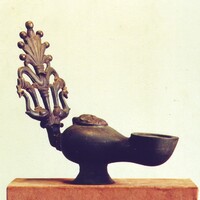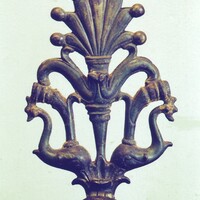Early Byzantine lamp in Thailand
Type:
Lamps
Date:
Fifth to seventh centuries
Location or Findspot (Modern-Day Country):
Thailand
Medium:
Bronze
Dimensions:
26.7 cm high × 29.5 cm long
Description:
This large bronze lamp was found at Pong Tuk in Thailand in the 1920s. It was made in the late antique (or early Byzantine) world between the fifth and seventh centuries. The pieces were cast separately, then soldered together. It was filled with oil through the hinged circular lid at the top of the body; a wick would have protruded from the end of the nozzle. The lid is decorated with the face of a Silenus, an elderly member of the retinue of the wine god Bacchus (Latin) or Dionysos (Greek). Projecting from the back of the lamp is a stylized palmette-shaped handle supported by two dolphins.
Dolphins appear frequently in Roman and late antique/early Byzantine lamps. They were associated with the classical god of wine, Bacchus or Dionysos, who was kidnapped by pirates whom he then transformed into dolphins. In a Christian context they may also have symbolized salvation from death, but there is no reason to assign a Christian meaning to this lamp. More generally, leaping dolphins were equated with leaping flames. The gold lamps that Emperor Constantine donated to his new Lateran Basilica in Rome were even called "dolphins" (the largest one had fifty dolphins).
This lamp probably arrived in Thailand via long-distance trade routes. It may have been made in Egypt, from which it traveled through the Red Sea to the Indian Ocean and then to Thailand. A sixth-century Greek merchant known to us as Kosmas Indikopleustes (the name means "sailer in Indian seas") described his travels as far as Sri Lanka, a stopping point for people and goods moving in both directions between southeast Asia and points farther west.
Dolphins appear frequently in Roman and late antique/early Byzantine lamps. They were associated with the classical god of wine, Bacchus or Dionysos, who was kidnapped by pirates whom he then transformed into dolphins. In a Christian context they may also have symbolized salvation from death, but there is no reason to assign a Christian meaning to this lamp. More generally, leaping dolphins were equated with leaping flames. The gold lamps that Emperor Constantine donated to his new Lateran Basilica in Rome were even called "dolphins" (the largest one had fifty dolphins).
This lamp probably arrived in Thailand via long-distance trade routes. It may have been made in Egypt, from which it traveled through the Red Sea to the Indian Ocean and then to Thailand. A sixth-century Greek merchant known to us as Kosmas Indikopleustes (the name means "sailer in Indian seas") described his travels as far as Sri Lanka, a stopping point for people and goods moving in both directions between southeast Asia and points farther west.
Relevant Textbook Chapter(s):
2,
3
Image Credits:
photo by OurTravelPics.com, used by permission



